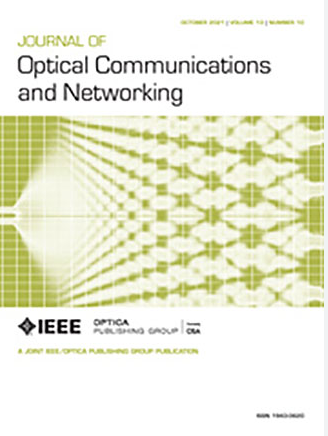Beyond 100G three-dimensional flexible coherent PON with time, frequency, and power resource-allocation capabilities
IF 4
2区 计算机科学
Q1 COMPUTER SCIENCE, HARDWARE & ARCHITECTURE
引用次数: 0
Abstract
Emerging services such as 8K/16K high-quality video streaming, virtual reality/augmented reality, beyond-5G mobile Internet, and edge computing are driving the need for even higher speed, capacity, and flexibility in optical access networks. Coherent passive optical networks (CPONs) have garnered significant attention in recent years due to their superior receiver sensitivity and high flexibility for 100G speeds and beyond. Research interest has surged in flexible, multi-dimensional multiplexing schemes that go beyond traditional time-division multiplexing (TDM). To further leverage the flexibility offered by CPONs, this paper proposes and experimentally demonstrates what we believe to be a novel three-dimensional flexible coherent PON (3D FLCS-CPON) for downstream applications. This system offers resource-allocation capabilities in the time, frequency, and power domains. By utilizing digital subcarrier multiplexing and power allocation in both the time and frequency domains, we achieve more flexible and adaptable access rates compared to traditional TDM and frequency-division multiplexing (FDM). We present in detail the operating principles of 3D FLCS-CPON in the downstream, along with steps for power calibration between subcarriers. As a proof of concept, we demonstrate the feasibility of 3D FLCS-CPON in the downstream using four subcarriers, achieving a peak data rate of超越 100G 具有时间、频率和功率资源分配能力的三维灵活相干 PON
8K/16K 高品质视频流、虚拟现实/增强现实、超 5G 移动互联网和边缘计算等新兴服务推动了对光接入网络更高速度、容量和灵活性的需求。近年来,相干无源光网络(CPON)因其卓越的接收器灵敏度和高度灵活性而备受关注,其速度可达 100G 及以上。研究人员对超越传统时分复用(TDM)的灵活、多维复用方案的兴趣激增。为了进一步利用 CPON 提供的灵活性,本文提出并实验演示了我们认为适用于下游应用的新型三维灵活相干 PON(3D FLCS-CPON)。该系统可在时域、频域和功率域提供资源分配功能。通过在时域和频域利用数字子载波多路复用和功率分配,我们实现了比传统 TDM 和频分多路复用(FDM)更灵活、适应性更强的接入速率。我们详细介绍了 3D FLCS-CPON 在下游的工作原理,以及子载波之间的功率校准步骤。作为概念验证,我们利用四个子载波演示了下行 3D FLCS-CPON 的可行性,在 20 千米光纤上实现了 ${250}\;{\rm Gb/s/}\lambda$ 的峰值数据速率。
本文章由计算机程序翻译,如有差异,请以英文原文为准。
求助全文
约1分钟内获得全文
求助全文
来源期刊
CiteScore
9.40
自引率
16.00%
发文量
104
审稿时长
4 months
期刊介绍:
The scope of the Journal includes advances in the state-of-the-art of optical networking science, technology, and engineering. Both theoretical contributions (including new techniques, concepts, analyses, and economic studies) and practical contributions (including optical networking experiments, prototypes, and new applications) are encouraged. Subareas of interest include the architecture and design of optical networks, optical network survivability and security, software-defined optical networking, elastic optical networks, data and control plane advances, network management related innovation, and optical access networks. Enabling technologies and their applications are suitable topics only if the results are shown to directly impact optical networking beyond simple point-to-point networks.

 求助内容:
求助内容: 应助结果提醒方式:
应助结果提醒方式:


